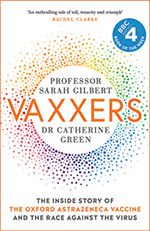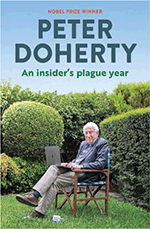Book reviews
Microbiology Australia 42(3) 148-148 https://doi.org/10.1071/MA21041
Published: 15 September 2021
Journal Compilation © The Authors 2021 Open Access CC BY-NC-ND, published (by CSIRO Publishing) on behalf of the ASM
Vaxxers: The inside story of the Oxford AstraZeneca vaccine and the race against the virus

|
Authors: Sarah Gilbert and Catherine Green, with Deborah Crewe
Publisher: Hodder and Stoughton, 2021
Paperback ISBN 9781 529369878. 336 pages, including 3 appendices, comprehensive notes and an index. Also available as a hardback.
In the Foreword of this book is the following quote:
Better to light a candle than curse the darkness — Anon.
Sarah Gilbert, Professor of Vaccinology at Oxford University, and her colleague, Catherine Green, certainly followed this adage, creating a vaccine that has given the world hope and the means to save lives and livelihoods. Furthermore, its accessibility is ensured by a commitment by AstraZeneca and Oxford University to provide the vaccine on a not-for-profit basis for the duration of the pandemic, and to low- and middle-income countries at no profit in perpetuity.
Gilbert and Green have written a truly thrilling and intimate record of how they created a highly effective vaccine in record time against a virus that has brought the world to its knees. For fellow scientists it is a fascinatingly detailed account of how the vaccine was conceived, developed, and produced, then trialled and manufactured and finally distributed. For readers from other backgrounds, particularly those labelled ‘vaccine hesitant’, the book carefully addresses every possible source of concern about the testing and trialling processes and the ultimate safety of the vaccine. A non-scientist friend to whom I lent my copy of the book said it demystified their research and that the explanations were clear and logical. She found the book informative and very accessible.
Gilbert and Green see their triumphant effort simply as the work that they needed to do to protect their fellow humans, certainly not as a route to fame and fortune. In fact, they both state that they look forward to the time when their lives and laboratory work regain their usual momentum. As they shared the task of bringing the vaccine to the world, Gilbert and Green also shared the task of writing the book, covering their area of input and often giving glimpses into very personal life experiences. Gilbert’s work coffee mug, typically an interesting insight into the user’s priorities and personalities, has the message, ‘Keep calm and make Vaccines’. At a time when we are being told to ‘Keep calm and get vaccinated’, it is sad that their Herculean effort is not seen more generally as the gift that it is, and its outcome, a safe and effective vaccine, not gratefully taken up by everyone without irrational and selfish objections.
Reviewed by Cheryl Power, Department of Microbiology and Immunology, Peter Doherty Institute for Infection and Immunity, The University of Melbourne
An insider’s plague year

|
Author: Peter Doherty
Publisher: Melbourne University Press, 2021
ISBN 9780522877519. 256 pages
A large section of this book consists of a series of essays that were first published on the Doherty Institute website in Peter Doherty’s weekly column ‘Setting it straight’, but he has added to these and extrapolated into the wider context that the current pandemic predicament sits. Along the way this Nobel laureate gives insight into the work of current and past Scientists; the insights gleaned from newer available technology; explains the current knowledge base and how these fit into the apparent speed of the institutional and scientific response to the COVID-19 pandemic. The last section of the book anticipates the future.
The intention of the original articles was to introduce in an ‘amiable way’ the whole area of infection and immunity to a lay reader, but in particular to shed some light for others not so intimately aware of the scientific response and the newer enabling technology that is behind the scenes of ‘what’s happening in this difficult time’.
Doherty reminds us of how the current COVID-19 pandemic fits in the human historical context, relates the current understanding of viral infections and of how vaccines work. He has made considerable effort to provide a gentle introduction to some very heavy science in a nonpatronizing and relaxed way. The scientific jargon is kept to a minimum, and what is included is explained in a rational way. The informal cross-referencing in the text keeps his readers on the right track when a clear understanding of a previously made concept comes into play again.
The reader obtains specialist information in small, guided parcels that engages interest through discussion of a very wide range of topics: personal insights into the life of a Nobel laureate, the history of science, people behind the scenes, and the work being done at the Peter Doherty Institute and elsewhere past and present.
The book provides an overview of a specialist scientific area in a way that the reader should be able to draw their own conclusions on events and decisions made in the public arena of this current pandemic. In the later chapters he links environmental and social aspects of the ‘why’ of such pandemics; and doesn’t shy away from the approach needed, and other problems that are intertwined with getting out of the current crisis and of avoiding others.
Peter also asks that we use science intelligently to solve other major problems without politicising the questions. He links the current predicament to big picture issues such climate change, biodiversity loss, as well as to social problems including housing and insecure incomes. He makes a comment on what should be the foreseeable damage done to Australia’s future due to the lack of support for the University sector (and not just for the sciences).
I thoroughly recommend that you read this book and think on the many issues, and the whole of the message it quietly conveys.
Reviewed by Barbara Porter, retired microbiologist but still an active reader and follower of all things microbiological


